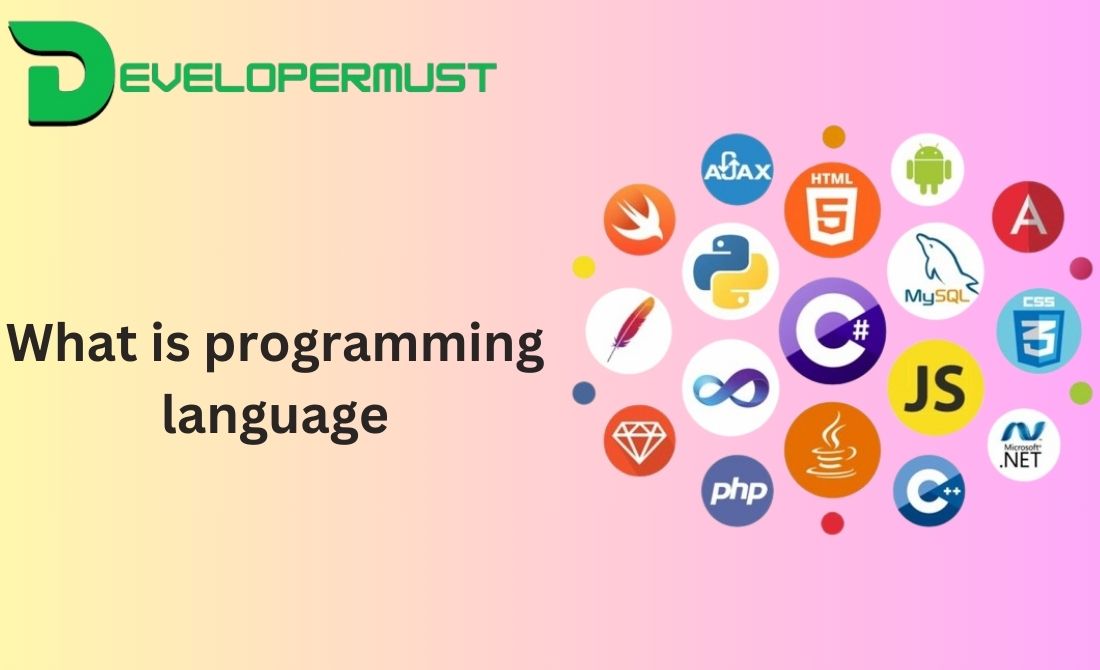Do you want to start a career in programming, but don’t know where to start? Do you wonder what a programming language is and how to choose a language to learn? Then you’ve come to the right place.
Choosing where to begin learning programming can be the most difficult part of learning software development. You can learn over 600 different programming languages, so your first look might feel like diving into the deep end. The most appropriate one often depends on what’s trending in the tech industry and what type of company you may want to work for in the future. The good news is that you don’t need to learn them all to become an effective programmer in your chosen field. To begin with, what exactly is a programming language?
What is a Programming Language?
Programming languages are used by programmers (developers) to communicate with computers. Visual programming languages generate graphical elements by converting string values into machine code based on a set of rules.
Generally, a program consists of a set of instructions written in a particular language (C, C++, Java, Python).
Cyber security bootcamps can benefit from the synergy of programming languages. Explore ethical hacking and defense strategies while mastering programming languages that power digital landscapes. From Python to C++, learn how to detect vulnerabilities and fortify systems against cyber threats.
Types of programming language
1. Low-level programming language
Low-level languages are machine-dependent (0s and 1s) programming languages. A processor runs low-level programs directly without the need for a compiler or interpreter, so programs written in low-level languages can run very quickly.
The low-level language is further divided into two parts:
-
Machine Language
Low-level programming languages include machine language. It is also known as machine code or object code. Because machine language is normally displayed in binary or hexadecimal form (base 16), it is easier to read.
A translator does not need to be used to convert the programs because computers directly understand machine language. Programmers benefit from machine language because it allows them to execute programs faster than high-level languages.
-
Assembly Language
Assembly language (ASM) is a low-level programming language designed for specific processors. It represents the set of instructions in a symbolic, human-understandable way. To convert assembly language to machine language, it uses an assembler. Assembler language is advantageous because it requires less memory and execution time.
2. High-level programming language
A high-level programming language (HLL) is used to develop user-friendly software programs and websites. Translating this programming language into machine language (executing the program) requires a compiler or interpreter. High-level languages are easy to read, write, and maintain.
The high-level programming languages include Python, Java, JavaScript, PHP, C#, C++, Objective C, Cobol, Perl, Pascal, LISP, FORTRAN, and Swift. code:mmmm
There are three parts to a high-level language:
-
Procedural Oriented programming language
Procedural Oriented Programming (POP) is based on the concept of procedure calls and is derived from structured programming. The program is divided into smaller procedures called routines or functions.
Software developers use procedural oriented programming language to write programs using IDEs, Adobe Dreamweaver, and Microsoft Visual Studio to write programs.
Programmers can easily track the program flow and reuse code in different parts of the program thanks to POP language.
- Object-Oriented Programming language
The object-oriented programming (OOP) language is based on objects. Programs are divided into small parts called objects in this programming language. The purpose of this is to make the program reusable, efficient, and easy to use by implementing real-life entities such as inheritance, polymorphism, abstraction, etc.
Object-oriented programming is faster, easier to maintain, modify, and debug than traditional programming techniques.
- Natural language
A natural language is a part of a human language, such as English, Russian, German, and Japanese. Machines use it to understand, manipulate, and interpret human language. It is used by developers to perform tasks such as translation, automatic summarization, Named Entity Recognition (NER), relationship extraction, and topic segmentation. The main advantage of natural language is that it enables users to ask questions about any subject directly and receive a response within seconds.
3. Middle-level programming language
A middle-level programming language sits between a low-level programming language and a high-level programming language.
As well as being called intermediate programming language, it is also referred to as pseudo-language. The advantages of middle-level programming languages include supporting high-level programming features, being user-friendly, and being closely related to machine and human languages.
What is the best web programming language
You can build a website or design a web application using different programming languages. The best web programming language depends on several factors, making it difficult to define. It might be worthwhile to consider the following options:
- Python: Python has many applications and is particularly suitable for the web due to its technical advantages.
- JavaScript: It is a client-side script that can be extended to serve different functions on the server.
- Java: A language that can be used for a variety of purposes, including web development.
- Go: Go is a general-purpose, flexible language that facilitates application development.
- Ruby on Rails: makes it easy to create web application.
Final Thoughts
All programming languages share some common features without sacrificing their individual identities. Languages are all designed to direct digital systems towards producing desired outcomes, but some are specialized while others are more general. Finding a suitable programming language could be the first step towards solving an elaborate problem, such as implementing an integration project.




